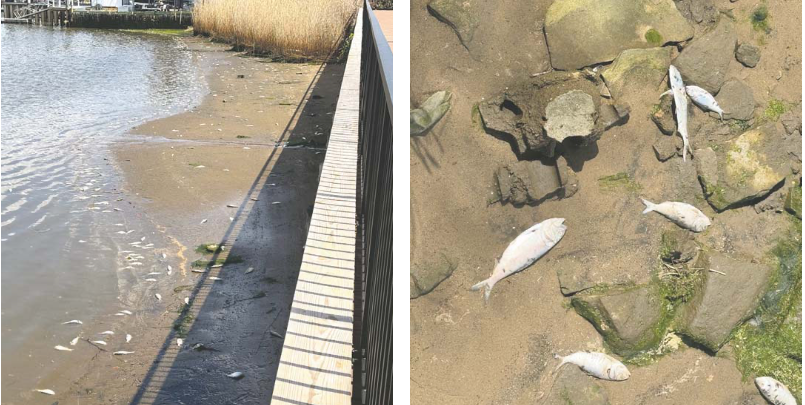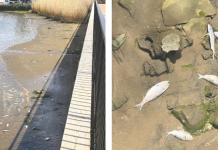
By Sunayana Prabhu
Not everything that blooms in the spring is pleasant. The first wave of warmer temperatures last week brought dead fish to area shorelines. The die-offs are still being investigated, but preliminary reports suggest excess algal bloom in the water depleted oxygen levels, almost suffocating the fish, resulting in mass deaths.
Thousands of dead menhaden, also called bunker fish, washed ashore along the Navesink River, Swimming River, Oceanport Creek and other areas. The nonprofit Clean Ocean Action has been working with the state Department of Fish and Wildlife to investigate the reason behind these die-offs.
“We got a sample from the Navesink and I looked at it on the microscope and saw a lot of algae in the water,” Bill Haddendorf, environmental specialist with the New Jersey Department of Environmental Protection’s (NJDEP) Bureau of Marine Water Monitoring said while presenting a bacteria update on a zoom video conference at the Rally for the Two Rivers public meeting April 28. The meeting was organized by Clean Ocean Action at the Little Silver Women’s Club to bring more awareness to river health in surrounding communities.
Haddendorf reported that the dead fish seen last week along the shores of the Navesink in Red Bank were killed by a “phytoplankton bloom that happened in mid-April.”
When members of Clean Ocean Action brought in samples, Haddendorf said he saw the algal bloom was dying off and, when such a bloom dies, it consumes oxygen in the water. “Right now, I think the belief is it was just a low dissolved oxygen event that is killing the menhaden,” Haddendorf said, noting a similar, although much more severe, occurrence in 2021. That die-off was largely due to a bacterium called “Vibrio anguillarum” in the Two River area waters, which is known to cause deadly hemorrhagic disease in some marine and fresh/brackish water fish, bivalves and crustaceans.
Swarna Muthukrishnan, Ph.D., water quality research director at Clean Ocean Action, said during the meeting that the current water samples showed similar “spinning and the erratic swimming” seen in the 2021 bacteria.
Haddendorf said experts will test water samples April 30 for this specific bacterial species.
Critical Buoys
To better understand and potentially predict these events, Haddendorf advocated for redeploying a continuous monitoring buoy in the Navesink River. The DEP has been asked to place a buoy in the Navesink by next March to track chlorophyll and oxygen levels before a die-off begins. “We’ve been seeing it every year. We’ve been seeing the dead bunker (fish) in the Navesink. So, we’re going to try and get that buoy out next year,” he said.
The DEP used to place one buoy in the Navesink River, another one in the Sandy Hook Bay and two in Red Bank, but removed them due to high costs. Haddendorf said. “We can look into maybe possibly getting one in the Shrewsbury as well, because I know they have the bunker issues as well over there,” he added.
Monitoring buoys are used to track a river’s health. These marine monitoring stations act as underwater watchdogs, collecting comprehensive environmental information every few seconds. The monitoring buoys track multiple parameters simultaneously, including oxygen levels, temperatures, salinity and nutrient concentrations.
“Typically, they measure what you call the salinity variation, monitor the redox potential,” Muthukrishnan said.
While expensive and labor-intensive to maintain, these devices provide insights into rapidly changing aquatic ecosystems. Scientists can detect sudden environmental shifts that might trigger fish die-offs or algal blooms.
Historically deployed during summer months, the buoys have become increasingly critical in understanding complex marine environments. “It’s a standard practice in impaired water- sheds,” Muthukrishnan said. The data collected is meticulously reviewed by state environmental agencies and published online, offering researchers and policymakers a continuous, detailed view of the marine ecosystem.
The article originally appeared in the May 1 – 7, 2025 print edition of The Two River Times.














